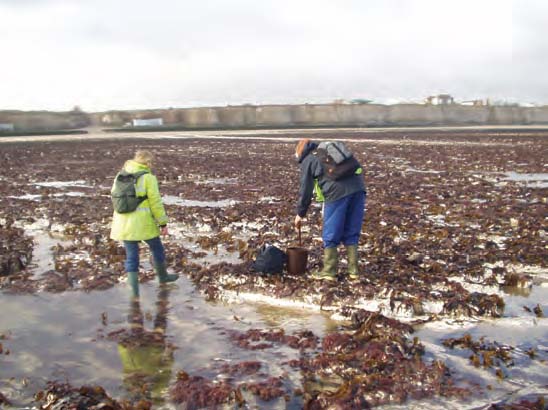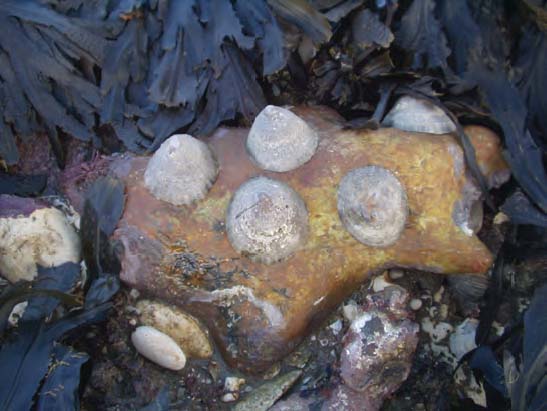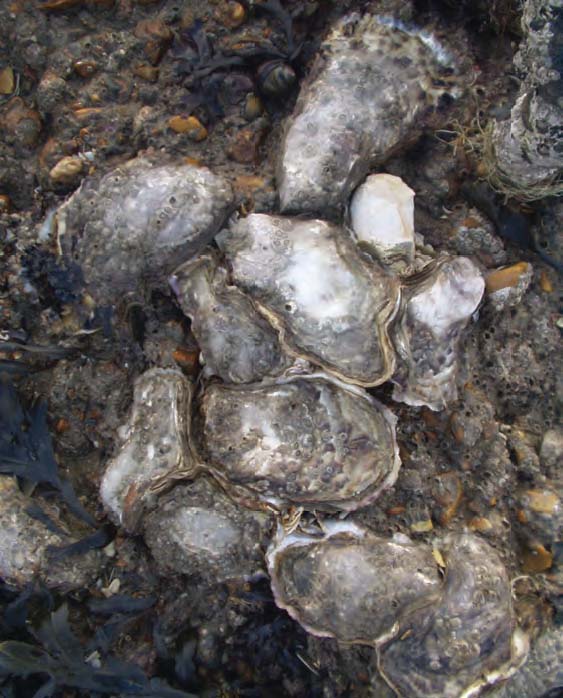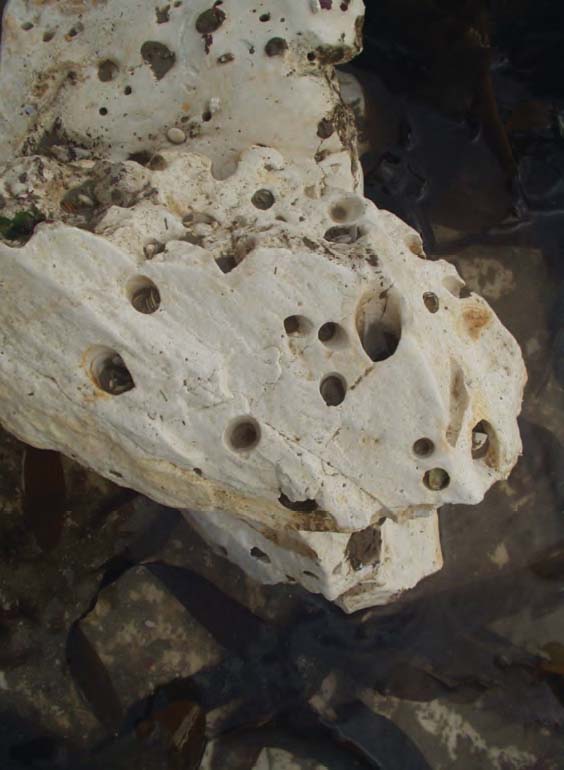|
For the past three years I have been collecting molluscs on Kent shores and have made some observations on how molluscs adapt to this difficult habitat: the Chalk. Chalk is a very pure limestone made up of the plates of very small algae called coccoliths. It was laid down in the Cretaceous age from 100 to 46 million years ago. About 200 metres of chalk remain in Kent. There are harder bands of marlstone and of flints; these may be in layers, tabular, elongate and blocky or scattered generally through the rock. Erosion has resulted in the formation of vertical cliffs and gently sloping shore and sub-tidal platforms in Kent and Sussex. These create a range of microhabitats. Splash-zone sea-caves support algal communities unique to the substrate. The generally soft nature of chalk results in the presence of a characteristic flora and fauna, notably rock-boring invertebrates such as the Spionid worm Polydora sp. and piddocks. Littoral chalk also usually lacks species common on hard rocky shores for example Pelvetia canaliculata and Ascophyllum nodosum, but otherwise supports the usual zones of algae and animals such as Fucus spp, kelps - Laminaria spp and red algal turfs, or barnacles and mussels on wave-exposed shores. Sub-littoral communities are confined to shallow water by high turbidity. Chalk habitats in south-east England are low in species richness due to the friable and easily eroded nature of chalk and the prevailing harsh environment, characterised by relatively high water temperatures, high turbidity, siltation and scouring. Due to extensive sea defences (in Thanet 74%) of the upper shore has been concreted over and so there are no splash zone communities. There is human disturbance of shore communities by trampling, stone-turning, small-scale fishery, and damage to rocks through removal of piddocks. In Kent there has been an incursion of several alien species: Portuguese oyster Crassostrea gigas, Japweed Sargassum muticum and others. You will be surprised that anything lives there, but it does! The Chalk platform is eroded into gullies, which run out to the sea. On exposed shores the top surface of the platform is more or less clear of weeds, shallow pools are inhabited by large numbers of winkles Littorina littorea. Less exposed areas become covered by sheets of mussels Mytilus edulis, which are preyed upon by dog whelks Nucella lapillus, Margate has a huge range of large, colourful and stripy forms. Below the Mytilus zone there are extensive covering of red rags Dilsea carnosa and Calliblepharis ciliata and small reds including Mastocarpus stellatus and Gelidium spp. Fucus serratus is the dominant brown weed on chalk in Kent; it mostly attaches itself to flints and to cracks in the chalk. Embedded and loose flints are thus an important microhabitat. Adhering directly to them are common limpets Patella vulgata and Portuguese oysters Crassostrea gigas. Living amongst the serrated wrack on the flints are periwinkles Littorina littoralis, flat winkles L. mariae, rough winkle L. saxatilis, and the grey and purple tops Gibbula cinerea and G. umbilicalis. Gibbula umbilicalis and Acanthochitona crinitus are recent arrivals to Kent; they have been extending their range from the Channel coast facilitated by a 20C warming over the last 10 years. Kent ShoreSearch and Lyn Thyer have been recording these changes recently. Crassostrea gigas, which attaches to lower shore flints, is also an invader, having spread from Whitstable where it is farmed. There is a sparse covering of small brown, green and red weeds that live on the sides of gullies, where it is less turbulent. Most of the macro shore fauna is to be found in the gullies: large numbers of common chitins Lepidochitona cinereus, limpets, periwinkles, rough winkles, grey tops and netted dog whelks Hinia reticulata live there. The micro-fauna living in the weeds comprises: Tricolia pullus, Dikoleps cutleriana, Lacuna vincta, L. pallidula, Rissoa parva, R. interrupta, Onoba semicostata, Alvania beani, A. punctura, A. semistriata, Odostomia unidentata, Brachystomia eulimoides, Modiolula phaseolinus, Mysella bidentata, Turtonia minuta and Hiatella arctica. The bottoms of the gullies contain fine black mud in which annelids live who are preyed upon by microscopic pyramidellids: Odostomia plicata, O. turrita, Brachystomia scalaris and Partulida spiralis. At the lower edge of the platform there are extensive reefs of Sabellaria spinulosa and the associated pyramidellid, Noemiaea dolioliformis and Graphis albida have been found. Below low tide there is an interesting association of pholads and Polydora worms. I believe that the only places where this is found in UK are Kent, Sussex and Devon. Pholas dactylus, Barnea parva, B. candida, Zirfaea crispata, Hiatella arctica and Polydora ciliata actively bore into the rock. On the surface of the borings are Osmundea pinnatifida and sponges, small red weeds and Botryllus spp. This rich habitat supports Painted tops Calliostoma zizyphinum, cowries Trivia spp, sting winkles Ocenebra erinacea, wentletraps Epitonium clathrus and E. clathratulum. In the holes vacated by the pholads two non-boring bivalves live: rugose carpet shell Venerupis senegalensis var saxatilis and American piddock Petricola pholadiformis. There are strong tidal currents through the Straits of Dover past Dover, Folkestone and Thanet. Many of the shells that end up on Sandwich Flats lived in the pholad community at Foreness Point. This area of Margate and Sandwich Bay has been awarded Special Area of Conservation (SAC) status under the UK Biodiversity Action Plan for its pholad community, chalk caves and of course birds on Sandwich Bay. Refs: Pain C J 1969-2007, Conchological Society of Great Britain & Ireland record sheets for Kent. UK Biodiversty Action Plan. www.ukbap.org.uk/habitats |
|
The Chalkface
Issue
15
Page
10

 1 Chalk platform and cliff at Foreness Point, Margate, Kent, covered by Dilsea carnosa and Calliblepharis ciliata . Photo. J.Llewellyn-Jones
1 Chalk platform and cliff at Foreness Point, Margate, Kent, covered by Dilsea carnosa and Calliblepharis ciliata . Photo. J.Llewellyn-Jones 2 Patella vulgata living on a flint at Foreness Point, Margate, Kent. Photo. J.Llewellyn-Jones
2 Patella vulgata living on a flint at Foreness Point, Margate, Kent. Photo. J.Llewellyn-Jones 3 Crassostrea gigas at Foreness Point, Margate, Kent. Photo. J.Llewellyn-Jones
3 Crassostrea gigas at Foreness Point, Margate, Kent. Photo. J.Llewellyn-Jones 4 Eroded chalk block with pholad holes at Foreness Point, Margate, Kent. Photo. J.Llewellyn-Jones
4 Eroded chalk block with pholad holes at Foreness Point, Margate, Kent. Photo. J.Llewellyn-Jones